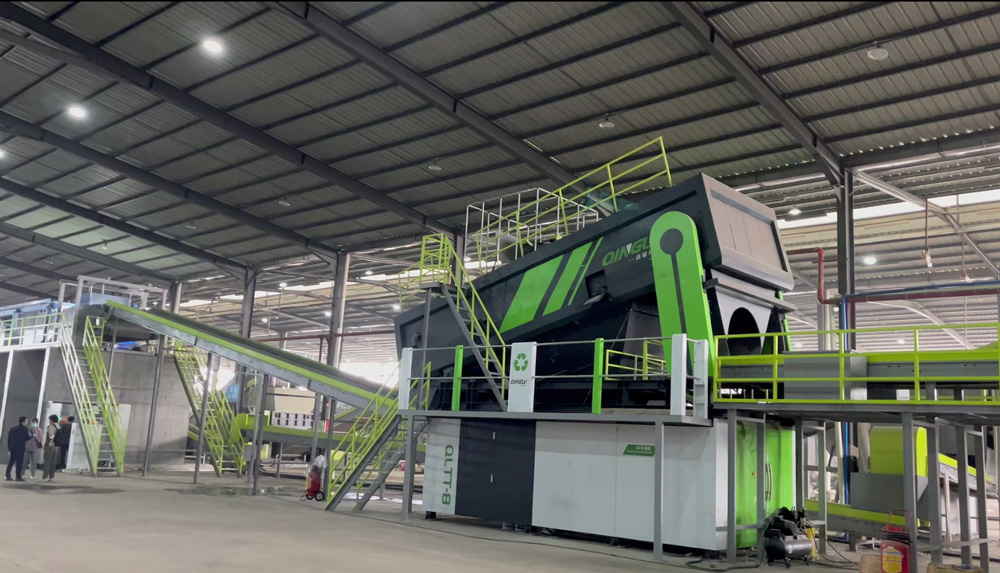 Time:2025-03-07
Time:2025-03-07
 Source:青绿环境
Source:青绿环境
In the context of accelerating urbanization, the volume of decoration waste is increasing day by day. This type of waste is highly complex and diverse in composition, including wood, plastic, metal, bricks, concrete, and more. If not effectively sorted and processed, it will not only occupy a large amount of land resources but also cause serious environmental pollution. The emergence of waste sorting equipment has provided a powerful solution for the efficient and environmentally friendly treatment of decoration waste. This article will detail how to sort decoration waste using waste sorting equipment.

I. Uniform Feeding Machine: Precise Control at the Source
The uniform feeding machine is the first piece of equipment in the decoration waste sorting process, tasked with stable material supply. With its unique design, it can evenly transport various types of decoration waste to subsequent processing equipment, ensuring the smoothness and stability of the entire sorting process.
When using a uniform feeding machine, operators need to adjust the feeding speed and quantity based on the volume of decoration waste generated and the processing capacity. Regular checks on the machine's operation are also necessary to clear any blockages and prevent uneven feeding from affecting the subsequent sorting results. For example, in large-scale decoration sites where a significant amount of waste is produced daily, if the feeding speed is too fast, it may overload the subsequent equipment; if it is too slow, it will reduce overall processing efficiency. Therefore, controlling the working parameters of the uniform feeding machine is crucial for improving the efficiency of decoration waste sorting.
II. Grate Screen and Rotary Screen: The Key to Coarse and Fine Separation
Grate Screen
The grate screen is primarily used for the preliminary separation of large and small materials in decoration waste. It utilizes the gaps between the grates to allow materials smaller than the gap to fall through, while larger materials remain on the screen surface and continue to move forward. This sorting method can quickly and effectively separate large-sized debris, such as furniture and appliances, from other smaller decoration waste.
In practical use, the grate spacing and screen inclination angle should be selected based on the specific characteristics of the decoration waste. Generally, the grate spacing should be adjusted according to the size of the materials to be separated, while the screen inclination angle affects the movement speed of the materials on the screen and the separation effect. For example, for decoration waste containing a large amount of large wood and bricks, the grate spacing and screen inclination angle can be appropriately increased to improve separation efficiency.
Rotary Screen
The rotary screen is more suitable for further subdivision of medium and small particle materials. Through the rotational movement of the drum, the materials continuously tumble and are sorted inside the drum. Materials of different particle sizes are gradually separated and discharged from different outlets as the drum rotates. The rotary screen has the advantages of compact structure, high screening efficiency, and stable operation, and can accurately classify various granular materials in decoration waste.
When using a rotary screen, it is important to control the drum speed and feed rate. Excessive speed may result in insufficient screening time for the materials inside the drum; while an excessive feed rate may overload the drum and affect the screening effect. In addition, regular maintenance and cleaning of the rotary screen are necessary to remove blockages in the screen holes and ensure the normal operation of the equipment.
III. Air Separator: A Powerful Tool for Light and Heavy Separation
The air separator is a device that uses airflow differences to separate materials and plays an important role in the sorting of decoration waste. It cleverly utilizes aerodynamic principles to effectively separate light materials (such as plastics and paper) from heavy materials (such as concrete blocks and metals).
When using an air separator, the appropriate airspeed and direction should first be adjusted based on the characteristics of the decoration waste and processing requirements. The airspeed directly affects the separation effect of the materials. If the airspeed is too low, it may fail to lift the light materials; if it is too high, it may blow away heavy materials, reducing the recovery rate. Second, maintaining a uniform and stable feed into the air separator is essential to avoid poor separation due to uneven feeding. Regular cleaning of dust and debris inside the air separator is also an important measure to ensure its normal operation.
For example, in the processing of decoration waste containing a large amount of plastic films and paper fragments, by properly adjusting the airspeed and direction of the air separator, these light materials can be accurately separated for subsequent recycling.
IV. Magnetic Separator: A Precision Tool for Metal Recovery
The magnetic separator is a device specifically designed to extract metal substances from decoration waste. It relies on a powerful magnetic field to easily separate metal components mixed in the waste. Whether it is scrap wire, nails, or larger metal components, the magnetic separator can capture them all with its precise magnetic identification ability.
When using a magnetic separator, the appropriate magnetic field strength and pole structure should be selected based on the type and content of metals in the decoration waste. Different types of metals have different magnetic properties, and only by choosing the right magnetic parameters can efficient metal recovery be achieved. It is also important to ensure uniform feeding to avoid metal materials sticking together or piling up, which can affect separation efficiency. Regular cleaning of iron filings and debris from the magnetic separator is also key to maintaining a clean and stable magnetic field and improving metal recovery rates.
For example, in the processing of waste decoration materials, the magnetic separator can effectively separate steel, aluminum, and other metal materials. After further processing, these metals can be reintroduced into production, achieving resource recycling.
V. Baler: Integration and Packaging After Sorting
After the decoration waste has been effectively separated through the aforementioned sorting equipment, the baler plays an important role. It integrates and packages the sorted and purified materials of various types, preparing them for subsequent resource utilization.
When using a baler, the appropriate packaging materials and methods should be selected based on the nature and volume of the materials. For recyclable materials such as wood, plastic, and metal, compression baling can be used to reduce volume for easier transportation and storage. For non-recyclable waste, proper sealing is necessary to prevent secondary environmental pollution. It is also important to ensure that the working pressure and temperature parameters of the baler are set correctly to guarantee the quality and safety of the packaging.
Sorting decoration waste using waste sorting equipment is a systematic and complex process. It requires the rational selection and use of various sorting devices based on the composition and characteristics of the waste. Through the collaborative action of uniform feeding machines, grate screens, rotary screens, air separators, magnetic separators, and balers, efficient and precise sorting and classification of decoration waste can be achieved, contributing to resource recycling and environmental protection. With the continuous development and progress of technology, it is believed that more advanced and efficient waste sorting equipment will emerge in the future, providing better solutions to the problem of decoration waste.













 Prev
Prev











